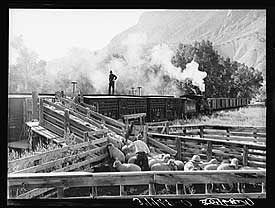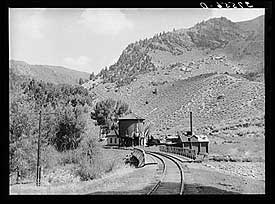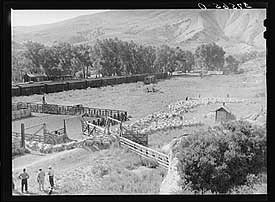
Photo by Russell Lee, Courtesy Library of Congress A LIVESTOCK SHIPPING HUB CHANGING TIMES Today, the National Park Service maintains a visitor center, campground and picnic area where the railroad town of Cimarron once existed. An outdoor exhibit with loading corrals and stock cars helps visitors understand the importance of the railroad history to Cimarron's ranching community and the entire western slope. Cimarron Town Map, 1919 and Today » (95k pdf) 
Photo by Russell Lee, courtesy Library of Congress When the first train arrived, the passengers were greeted by a host of tents and a single log cabin. Many believed that as the railroad continued on west, Cimarron would disappear. But by the end of 1882, it was recognized that getting trains over the steep Cerro Summit grade would require helper engines. Cimarron developed into a real railroad town, complete with a roundhouse and station facilities. The original purpose of this railroad was to provide a link for shipment of ore from the mines in the San Juan mountains. However, scenic excursions also ran through Cimarron in the latter part of the 19th and into the 20th centuries. A subsidiary of the D&RG, the "Rio Grande Hotel Company", established the "Black Canyon Hotel and Eating House" in Cimarron. Railroad passengers came to eagerly anticipate the stop in this community known for its hospitality. Its population fluctuated drastically during this time, at times soaring to 250 or dwindling to 25. 
Photo by Russell Lee, courtesy Library of Congress Cimarron Town Map, 1919 and Today » (95k pdf) |
Last updated: August 2, 2023
